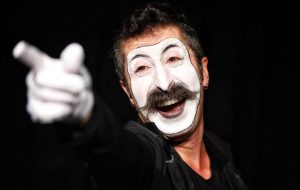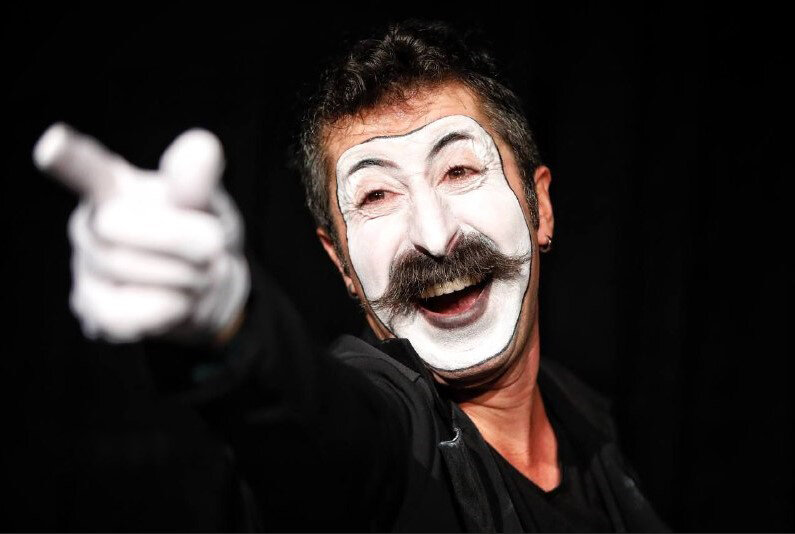From Turkey to Iran: Onur Kaya shares his journey in children’s theater
HAMEDAN- Turkish artist Onur Kaya brought his unique talents to the vibrant city of Hamedan as part of the international section of the 29th edition of Iran’s International Theater Festival for Children and Young Adults, held from November 1 to 7. In a 20-minute pantomime, Kaya impressed audiences with his artistry and shared his reflections


HAMEDAN- Turkish artist Onur Kaya brought his unique talents to the vibrant city of Hamedan as part of the international section of the 29th edition of Iran’s International Theater Festival for Children and Young Adults, held from November 1 to 7.
In a 20-minute pantomime, Kaya impressed audiences with his artistry and shared his reflections on the world of children’s theater.
In an interview with the Tehran Times, Kaya expressed his initial surprise upon discovering that the children’s theater in Hamedan has been running for such a long time—specifically, for 29 years. “I did not know that Hamedan’s children’s theater has been ongoing for so long,” he confessed.
He spoke positively about the long-established festival, noting that its history has cultivated a culture and audience for children’s theater in the region. “My impressions of the festival are good. In my country, it is done largely in a similar way,” he explained, drawing parallels between the theatrical landscapes of Turkey and Iran.
He praised the festival for its longevity and the high quality of participating groups, remarking, “Hamedan is a very good and modern city in Iran, and what is surprising is the number and quality of several theater venues around the city.”
When asked about the themes that resonate within children’s theatrical productions, Kaya emphasized that children’s theater does not always have to convey a specific message. “I do not think children’s theater should always have a specific message,” he stated. While he recognizes the value of educational aspects, he believes the primary goal should be entertainment: “This in itself has many benefits.”
Describing his creative process, Kaya pointed to his background in pedagogy as a vital component in working with children. “When working with children, we should consider games specific to their age group,” he noted. He underlined the importance of creating experiences that respect the innocence of childhood, asserting that theater for young audiences should be engaging without being overly didactic.
Kaya reflected on how Iranian children engage with performances, noting, “There is no difference between children in Iran and children in other countries. They are all participants, they are all excited, they are all full of energy.”
Looking ahead, Kaya expressed enthusiasm about potential collaborations between Iranian and Turkish artists. “Cultural fusion and collaboration could be a good idea,” he said, sharing his desire to stage a theater play featuring actors from both countries. He also mentioned his work as a producer, emphasizing the potential richness of storytelling that could arise from intercultural projects.
Regarding the educational impact of theater, Kaya asserted that the lessons imparted begin even before children enter the theater. “What it brings to children should start at the door before entering the theater,” he explained. He emphasizes the importance of teaching children values such as punctuality and planning while also providing experiential learning opportunities through engaging performances.
Kaya further discussed the broader implications of children’s theater in fostering cultural understanding. He recognized the intrinsic value of international collaborations, declaring, “Getting to know directors from other countries is beneficial in itself.” He believes that such interactions can cultivate a deeper understanding among diverse communities.
In closing, Kaya expressed hope for a more connected world, free from geopolitical tensions. “I hope that in the near future the world will be as soft and peaceful as a child’s heart,” he remarked.
The 29th Iran’s International Theater Festival for Children and Young Adults was organized by the Dramatic Arts Center of the Ministry of Culture and Islamic Guidance, supported by Hamedan Municipality and in partnership with the Hamedan province’s Cultural and Islamic Guidance Office, as well as the Iranian Dramatic Arts Association.
Six international groups from Uzbekistan, Armenia, Iraq, Brazil, Turkey, and Russia, as well as special guests from Morocco, attended this edition of the festival.
The event aimed at enhancing unity and companionship, growth, awareness, and the confidence of Iranian children through the medium of theater as well as achieving social participation of children and adolescents, promoting public culture, strengthening the foundations of family and intergenerational communication, and educating citizens and increasing responsibility through the active participation of Iranian children and adolescents in the production of theatrical works.
With the motto “Theater: Dialogue Without Borders”, the 29th edition of Iran’s International Theater Festival for Children and Young Adults was held from November 1 to 7.
Photo: Turkish artist Onur Kaya performs during the 29th Iran’s International Theater Festival for Children and Young Adults in Hamedan.
SAB/
